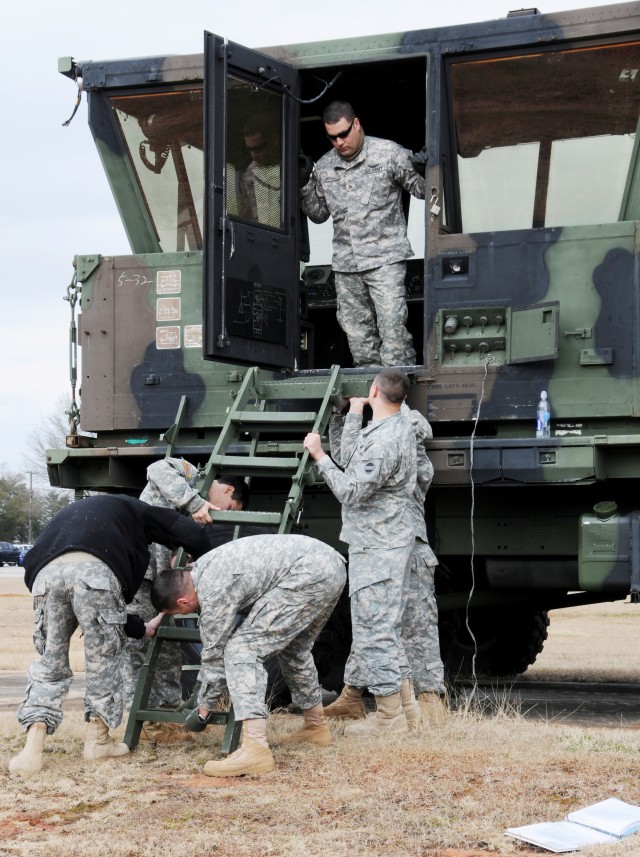
FORT RUCKER, Ala. -- Air Traffic Services Command officials made history recently by hosting the first Contingency Airfield Management Workshop here.
The three-week course better prepared about 50 Soldiers to work alongside U.S. and Middle Eastern military services to manage airfields.
Instructors designed the course to bring the Army in line with Air Force and Marine Corps airfield management capabilities, said Lt. Col. Paula Alberto, ATSCOM executive officer. Soldiers frequently work with other services during deployments, and need to be on the same level as their peers and knowledgeable about the other branch-specific regulations, she noted.
Servicemembers set up a mock airfield with temporary tactical control towers on Guthrie Airfield Feb. 1 to gain hands-on experience for future assignments. Scenarios included working with friendly Middle Eastern forces, and reacting to simulated explosions and attacks on the field.
Squadron Safety Officer CW4 Michael Jones said he will take back knowledge learned here to his 6th Squadron, 6th Cavalry Regiment, Fort Drum, N.Y., unit.
"It helps us in understanding Air Force operations and making sure we're able to coordinate with airfield assets," he said.
Sgt. Maj. Teddy James, from South Haven, Miss., National Guard's 2nd Battalion, 185th Aviation Regiment, attended with five other unit members and said the hands-on, real-world training scenarios were much needed to prepare for their future deployments.
"We're now better prepared for future airfield operations," James said. "We know the different services' standards."
Most course instructors are stationed here at Fort Rucker, but representatives from other services collaborated to lead air traffic service Soldiers from around the country during the last two weeks of January and the first week of this month.
Air Force Master Sgt. Jim Blevins, airfield management contingency manager at Tinker Air Force Base, Okla., said teaching airfield safety here gave him different perspectives about establishing facilities during deployments.
Instructing Soldiers creates more deployable ATS servicemembers, helping increase Air Force members' dwell times at home, Blevins said.
"Joint operations benefit both sides," he said. "It's a cross-flow of information."
Lt. Col. Jon Greenhaw, 1st Battalion, 245th Aviation Regiment, Lexington, Okla., National Guard commander, traveled here with several fellow guardsmen "to bridge the gap until TRADOC (Training and Doctrine Command) creates (similar) courses."
The Army fields 10 Airfield Operations Battalions - like the 1-58th AOB here - and two Theater Airfield Operations Groups, including Fort Rucker's 164th TAOG, Greenhaw said. Bringing Soldiers from these units up to speed on joint airfield management tactics and rules is critical for future success.
"It's an eye opening experience to understand how complex airfield management is," he said. "It's a joint effort."
The complexities involve varying standards between different U.S. military services and Army branches, coordinating with host nations and contractors and even facing temperamental weather, said the Oklahoma unit's Sgt. Maj. Danny Matthews.
The unit will eventually deploy, and Greenhaw said he believes his Soldiers are better equipped to face any challenges the Middle East brings.
"We know who to ask (and) what references we need to use. We know the lessons learned and the challenges we've faced in the past. It's given us a way to plan to be successful," he said.
As a former UH-60 Black Hawk maintenance test pilot, unit Safety Officer CW4 Kirk Little said the workshop helped him bridge the gap between Aviation and ATS.
"It helps me intertwine the two (branches) because I'm used to talking to air traffic controllers," Little said. "(This course) gives me a more well-rounded knowledge of what they go through. Now I can see it from both sides of the house and what to expect."
Commanders' and senior noncommissioned officers' feedback about the course was positive, with each Soldier advocating to continue the new workshop in the future.
"I think this course is great. It needs to continue to be resourced. Our units need this training," said Major Marlon Brannan, 2nd Bn., 185th Avn. Regt. ATC officer.
Due to the course's success here, Alberto said she anticipates holding another similar workshop sometime this spring.

Social Sharing